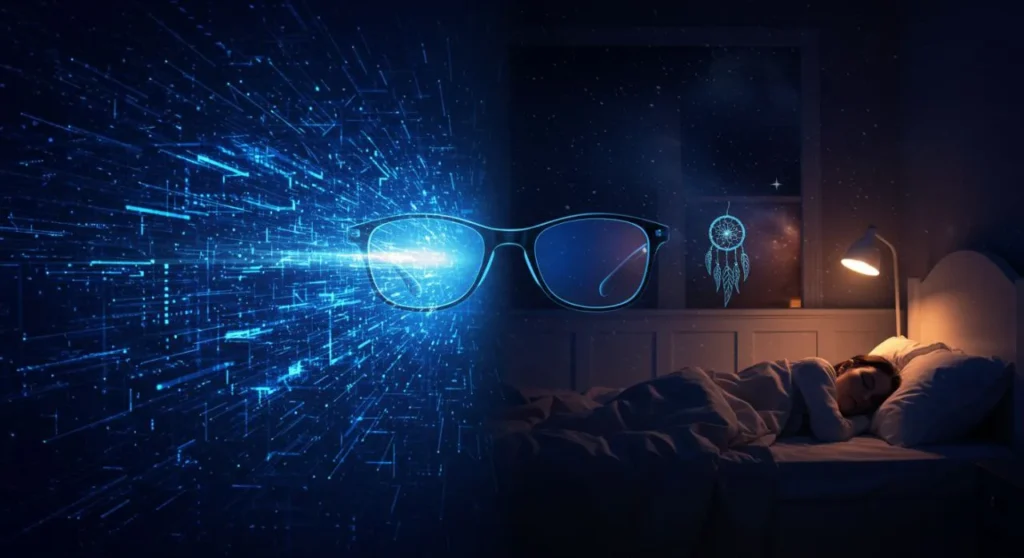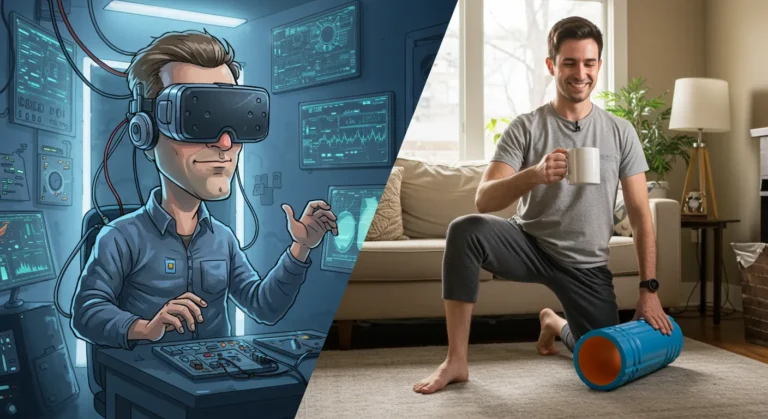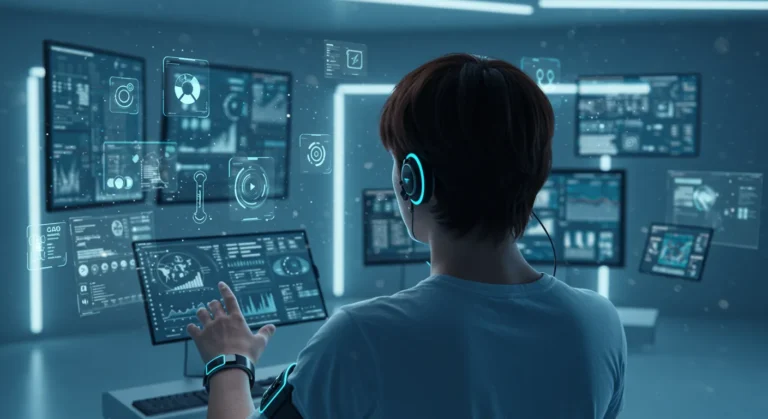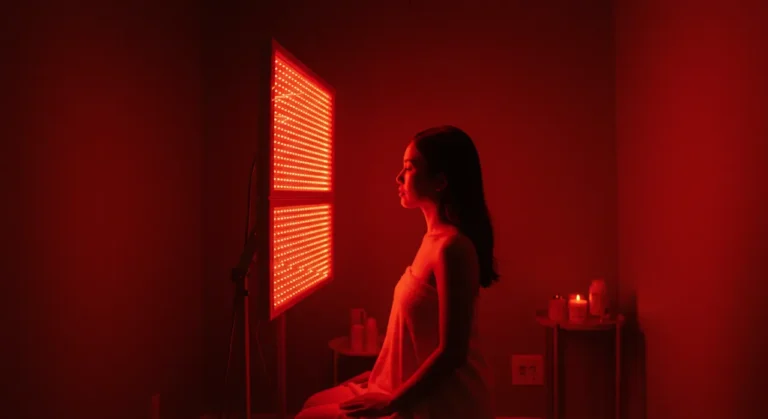Blue Light Blocking Glasses: Do They Actually Work? (5 Top Picks)

Ever catch yourself rubbing your eyes after a marathon work session, wondering why they feel like sandpaper? Or maybe you’re lying in bed at midnight, exhausted but somehow wide awake after scrolling through your phone?
Welcome to the modern digital dilemma. We’re spending more time staring at screens than ever before, and our eyes—along with our sleep—are paying the price.
The solution everyone’s talking about? Blue light blocking glasses. But here’s the thing: half the information out there is marketing hype, and the other half is confusing science jargon.
Let me cut through the noise and share what actually works.
The Real Deal About Blue Light (And Why Your Sleep Suffers)
Picture this: You’re winding down for the evening, laptop open for “just one more email.” What you don’t realize is that your screen is essentially a mini sun, beaming blue light directly into your eyes.
Your brain, being the ancient survival machine it is, thinks it’s still daytime. So it shuts down melatonin production—the hormone that makes you sleepy. Result? You’re tired but wired, tossing and turning while your mind races.
Here’s what the research actually shows:
Blue light exposure in the evening can delay sleep onset by up to 30 minutes. That might not sound like much, but when you’re already sleep-deprived, every minute counts.
But there’s more to the story than just sleep. Many people report digital eye strain symptoms: dryness, burning, headaches, and that general “fried” feeling after long screen sessions.
Now, before you think blue light glasses are some miracle cure, let’s get realistic about what they can and can’t do.
Separating Fact from Fiction
Myth #1: “Blue light glasses cure eye strain completely.”
Not quite. Most digital eye strain comes from reduced blinking and prolonged focus, not just blue light exposure. Think about it—when you’re absorbed in work, you literally forget to blink normally.
Myth #2: “Any blue light glasses work the same.”
Definitely false. I’ve tested cheap pairs that barely filter any meaningful wavelengths. They’re essentially regular glasses with a marketing sticker.
The truth? Quality blue light blocking glasses can support better sleep by allowing natural melatonin production. They’re not magic, but they’re a useful tool in your wellness toolkit.
Here’s a quick story that illustrates this perfectly: Giulia, my colleague, used to power through 8-hour design sessions without breaks. Her eyes would be burning by evening, and falling asleep took forever. She started wearing blue blockers during late-afternoon work sessions and noticed two things: less eye dryness during the day, and an easier transition to sleep at night.
Not a complete transformation, but definitely noticeable improvements.
The 5 Best Blue Light Blocking Glasses Worth Your Money
After testing countless pairs (and reading way too many reviews), here are the standout options that actually deliver:
1. Gunnar Intercept Crystal – The Heavy-Duty Option
Best for: Gamers and people who spend 6+ hours daily on screens
These aren’t winning any fashion awards, but they’re built for performance. The best blue light glasses for serious screen time, blocking up to 65% of blue light with anti-reflective coating.
The trade-off: The amber tint is noticeable. Colors look slightly warmer, which some people love and others find distracting.
Bottom line: If function trumps fashion, these are solid men’s blue light glasses (though they work great for anyone).
2. Ocushield Blue Light Glasses – The Clear Choice
Best for: People who want protection without changing how things look
Ultra-lightweight with virtually clear lenses, these anti blue light glasses filter harmful wavelengths while maintaining color accuracy. Perfect for video calls where you don’t want the amber tint.
The limitation: Less effective for evening melatonin support compared to amber-tinted options.
Perfect if: You need all-day wear and can’t compromise on appearance.
3. QUAY Australia Blueprint – The Style Winner
Best for: Fashion-conscious folks who refuse to sacrifice looks for function
Finally, blue light filter glasses that don’t scream “I’m wearing computer glasses.” QUAY nailed the style factor while still providing meaningful protection.
The catch: Slight color shift from the lens tint, and they’re pricier than basic options.
Worth it for: People who want blue lens glasses that complement their personal style.
4. NoCry Over-Glasses – The Prescription Solution
Best for: People who already wear prescription glasses
Clip-on design that fits over existing glasses. No need for expensive prescription blue light reading glasses—just clip these on when you’re at your computer.
The reality: They’re bulkier than regular glasses and can feel awkward at first. But for prescription wearers, they’re a game-changer.
Smart choice if: You don’t want to invest in prescription blue light lenses right away.
5. Blue Block Reading Glasses +1.00 – The Budget Pick
Best for: People who need reading glasses anyway
Why not kill two birds with one stone? These combine reading magnification with blue light filtering at a fraction of the cost of premium options.
The limitation: Fixed magnification levels and basic filtering compared to specialized blue screen glasses.
Good entry point: If you’re testing the waters without a big investment.
How to Actually Choose the Right Pair (No BS Guide)
Forget the marketing fluff. Here’s what actually matters:
For better sleep: Go with amber or orange-tinted lenses. They block more of the spectrum that interferes with melatonin. Think of them as blue blocker glasses for evening use.
For all-day wear: Clear or lightly tinted lenses maintain color accuracy while providing some protection. These work well as general best blue light blocking glasses for daily use.
For existing glasses wearers: Clip-ons or prescription lenses with blue light filtering. Don’t double up on regular glasses plus blue light glasses—it’s uncomfortable and looks odd.
For style-conscious users: Brands like Ray-Ban now make Ray Ban blue light glasses that look identical to their regular frames.
Quick decision tree:
- Primarily evening computer use? → Amber tinted
- All-day office work? → Clear or light tint
- Already wear glasses? → Clip-ons or prescription add-on
- Style is non-negotiable? → Designer brands with filtering
What Real Users Actually Say (The Unfiltered Truth)
“I was skeptical, but after two weeks with BON CHARGE glasses, I’m falling asleep 20 minutes faster. The amber tint takes getting used to, but it’s worth it.” – Sarah, graphic designer
“Felix Gray glasses never created that weird glare during Zoom calls like my old pair. Plus, my eyes don’t feel fried by 5 PM anymore.” – Health magazine test panel feedback
“Tried three different brands before finding ones that fit comfortably with my headphones. Comfort matters more than I thought.” – Mike, software developer
The pattern I see in reviews? People notice gradual improvements rather than dramatic overnight changes. Better sleep quality, less eye fatigue, fewer headaches during long work sessions.
The Bottom Line (And What Nobody Tells You)
Blue light blocking glasses aren’t a magic bullet, but they’re a low-risk addition to your digital wellness routine. Think of them like sunglasses for your screens—useful protection that supports your body’s natural rhythms.
The real secret? They work best as part of a broader approach: taking regular breaks, dimming screens in the evening, and maintaining good sleep hygiene.
Start here: Pick one pair based on your primary use case. Wear them consistently for two weeks. Pay attention to how you feel, especially your evening energy and sleep quality.
Most people notice subtle but meaningful improvements. Your eyes feel less strained, you transition to sleep more easily, and those afternoon energy crashes become less frequent.
Ready to test them out? Any of the five options above will give you a legitimate trial run. And if you’re curious about other simple biohacking tools that actually work, check out our guides on natural energy optimization and sleep improvement strategies.
No guru nonsense. Just practical tools that make everyday life a little better.
Disclaimer: The information provided is for educational purposes only, not a substitute for professional medical advice. Always consult a healthcare professional.




